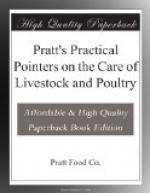Feeding and drinking places should be clean and the water supply pure. Unless the origin is known to be uncontaminated and there has been no possibility of infection during its course, hogs should not be allowed access to any stream. Wallows should be drained out or kept filled up as much as possible. At least once a month the quarters should be disinfected with a solution of Pratts Dip and Disinfectant. These precautions will be found valuable aids in the destruction of the various animal parasites, as well as a protection from some more serious troubles.
The methods of feeding and management outlined above have been successfully followed by hog growers for many years. They are conservative and safe. But during recent years a new method of feeding has been developed and is being generally adopted, especially by specialists who make hog growing a real business. This is known as the “self-fed” plan, under which system feed is kept before the hogs at all times and they are permitted to eat at will. In poultry feeding this is called “the dry mash system.”
Just who deserves credit for originating or developing this plan cannot be stated. That it is a good one is evidenced by the fact that it has received the endorsement of the Bureau of Animal Industry, United States Department of Agriculture; of many Agricultural Experiment Stations; of the specialty swine journals; of practical hog breeders in all sections of the country.
For this self-feed plan it is claimed that both feed and labor are saved, thus reducing production costs. That a 250-pound hog can be grown in thirty days less time than is possible where slop-feeding is practiced, thus getting the hogs to market earlier and avoiding danger of loss during this time. That it produces pork of highest quality, the meat being fine in flavor, firm, and with lean and fat well distributed.
Advocates of the self-feeding plan make the following comparison with the old-time slop-feeding method:
When dry food is supplied in automatic feeders, the attendant may fill the feeders at any convenient time of day and that at intervals of several days. In slop feeding, the meals must be prepared and fed twice daily, usually when other duties are pressing and time especially valuable.
When dry, ground grains are kept before the hogs at all times, they eat when they feel the need of food and are not liable to overeat at any time. Because of the dry character of the feed, they eat slowly, masticating the food thoroughly and mixing it with saliva. This means more thorough digestion and an absence of indigestion and bowel troubles. And, of course, quicker growth.
Slop-fed hogs, on the other hand, get very hungry between meals. At feeding time they pile up around the troughs, the stronger rushing and pushing away the weaker ones, those that really need the feed the most. Then they bolt the food without chewing it, taking all they can hold and leaving little for those that cannot find a place at the “first table.”




